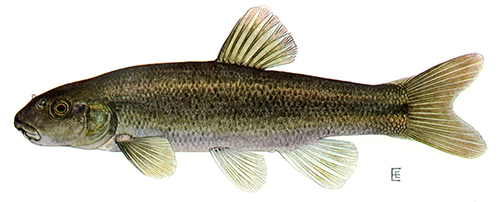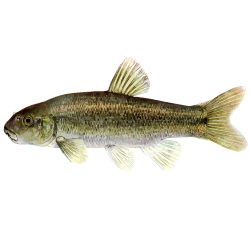Cutlip Minnow

Photo credit: New York State Department of Environmental Conservation
Species information
The following is a report on progress made towards the protection and recovery of Cutlip Minnow (Exoglossum maxillingua) in Ontario, from 2007 to 2018, based on species-specific policy. This report meets the legislative requirement for a review of progress under the Endangered Species Act, 2007 (ESA or “the Act”). Cutlip Minnow is listed as threatened on the Species at Risk in Ontario (SARO) List under the ESA.
Cutlip Minnow has been classified as a species at risk in Ontario since 2000. It was originally classified as threatened, and retained its ‘threatened’ status under the ESA, when it came into force in 2008.
As a threatened species, Cutlip Minnow has been protected from being killed, harmed, harassed, captured or taken, under the ESA, since 2008.
In addition, its habitat has been protected from being damaged or destroyed, since 2013, based on the general definition of habitat in the Act.
The species-specific policy for Cutlip Minnow, known as the Government Response Statement (GRS), was published in 2014, and includes the government’s recovery goal for the species, and the actions and priorities it leads or supports to help achieve that goal. The GRS considers science advice provided in the recovery strategy when developing recovery actions for the species. As legislated in the Act, the purpose of the Review is to report on progress made towards implementing the protection and recovery actions in the GRS. The Review can also help identify opportunities to adjust and adapt the implementation of protection and recovery actions to achieve the recovery goal for the species.
Further information about Cutlip Minnow, including the threats it faces and actions being taken to help protect and recover this species, is available on the Government of Ontario webpage for Cutlip Minnow. A summary of progress made towards the protection and recovery of Cutlip Minnow, and an annual update on the species at risk program, are available on the Review of Progress towards the Protection and Recovery of Ontario’s Species at Risk webpage.
Snapshot
Progress towards the protection and recovery of Cutlip Minnow
- The recovery goal stated in the Government Response Statement (GRS) for Cutlip Minnow in Ontario is to
maintain and increase numbers in existing populations, and where feasible, to restore habitat quality in formerly occupied locations that have the potential for natural recolonization.
- Progress has been made towards implementing all government-led actions in the GRS. Progress has also been made towards achieving all government-supported recovery objectives, and implementing associated actions. Examples of progress include:
- Conducting inventory and monitoring at known and historical locations to improve understanding of the status of populations and habitat requirements;
- Supporting partners to undertake activities to protect and recover Cutlip Minnow and its habitat; and,
- Increasing awareness about Cutlip Minnow and its habitat through education and outreach.
- In alignment with the GRS, further work is required to investigate the movements for all life stages of Cutlip Minnow, evaluate the potential impacts of other aquatic species (for example, Common Shiner (Luxilus cornutus) and Round Goby (Neogobius melanostomus) on populations, and restore degraded habitat at current and historical locations to support the recovery of the species.
Occurrence and distribution
- Ten populations
footnote 1 of Cutlip Minnow have been documented in the St. Lawrence and lower Ottawa River drainage areas. Currently, eight of these populations are extant, whereas the remaining two are considered historicalfootnote 2 . - Since 2008, two populations of Cutlip Minnow have been newly-identified, and one population changed from historical to extant as its existence was confirmed through monitoring efforts.
Government-supported stewardship projects
- Through the Species at Risk Stewardship Program, the Government of Ontario has enabled its stewardship partners to conduct 14 projects that have supported the protection and recovery of Cutlip Minnow. Five projects ($112,150) focused exclusively on Cutlip Minnow, while the other nine projects ($278,261) focused on multiple species at risk, including Cutlip Minnow.
- The government’s support helped its stewardship partners to involve 389 individuals who volunteered 7,382 hours of their time towards protection and recovery activities for species at risk, including Cutlip Minnow. The estimated value of these voluntary contributions, as well as additional funding and in-kind support, is $599,604.
- Stewardship partners reported providing outreach on multiple species at risk, including Cutlip Minnow, to more than 21,000 individuals.
Supporting human activities while ensuring appropriate support for species recovery
- The Government of Ontario has issued eight protection or recovery permits under clause 17(2)(b) of the Endangered Species Act, 2007 (ESA).
- Three agreements were entered into for Cutlip Minnow. These agreements were enabled through Ontario Regulation 242/08 (prior to the July 1, 2013 amendment).
- Twenty-four activities have been registered for the species, under the ‘Aquatic species’ (section 23.4), ‘Drainage works’ (section 23.9), ‘Species protection, recovery activities’ (section 23.17), and ‘Threats to health and safety, not imminent’ (section 23.18) sections of Ontario Regulation 242/08, under the ESA.
Reporting on progress towards the protection and recovery of Cutlip Minnow
Recovery Goal
The government’s goal for the recovery for Cutlip Minnow is to maintain and increase numbers in existing populations, and where feasible, to restore habitat quality in formerly occupied locations that have the potential for natural recolonization.
The implementation of government-led and government-supported actions demonstrates progress towards reaching the desired objectives and the recovery goal set out in the GRS for the species.
Progress towards implementing government-led actions
Progress has been made towards implementing all of the government-led actions. Common actions for the government to lead as it works toward achieving a species’ recovery goal include:
- Educate other agencies and authorities involved in planning and environmental assessment processes on the protection requirements under the ESA.
- Encourage the submission of Cutlip Minnow data to the government’s central repository at the Natural Heritage Information Centre (NHIC).
- Undertake communications and outreach to increase public awareness of species at risk in Ontario.
- Protect the Cutlip Minnow and its habitat through the ESA.
- Support conservation, agency, municipal and industry partners, and Indigenous communities and organizations to undertake activities to protect and recover the Cutlip Minnow. Support will be provided where appropriate through funding, agreements, permits (including conditions) and/or advisory services.
- Establish and communicate annual priority actions for government support in order to encourage collaboration and reduce duplication of efforts.
Additionally, the government has directly undertaken the following species-specific actions.
- Continue to implement the Ontario Invasive Species Strategic Plan to address the invasive species (for example, Round Goby) that threaten Cutlip Minnow.
Key progress made towards implementing these actions is described in the following sections.
Ontario’s Invasive Species Act
The GRS for Cutlip Minnow indicates that invasive species (for example, Round Goby) pose a threat to the survival and recovery of the species in Ontario. The Ontario Invasive Species Strategic Plan, 2012 and the Invasive Species Act, 2015 provide the policy and legislative framework to support the prevention, detection and control of invasive species in Ontario. This framework may support the implementation of actions to reduce threats from invasive species.
Occurrence and distribution
Ten populations
Since 2008, the government’s central repository at the Natural Heritage Information Centre (NHIC) has received 71 records of the species. These records are based on observations made between 1936 and 2017 and come from a variety of sources. Records submitted have helped to refine where the species is known and has been known to occur and have provided additional information on the species’ habitat and threats.
Based on NHIC records, five populations that were observed before 2008 were re-confirmed after 2008. Additional survey efforts since 2008 also re-confirmed the existence of a population in Hosaic Creek previously considered historical. Importantly, one new population was identified in the St. Lawrence River near Macdonell and island. These efforts have significantly increased our knowledge about the species’ distribution and numbers. The newly identified populations are likely the result of increased search effort and education about Cutlip Minnow and may not represent actual population increases, but rather increased knowledge about the distribution of the species. It is possible that there are observations of Cutlip Minnow that have not been submitted to the government. Encouraging the submission of observations of this species to the government is included in the GRS as a government-led action. Submission of species observations increases our knowledge of where they occur and can play an important role in assessing the viability
Everyone is encouraged, or may be required by an authorization or approval to submit observations of Cutlip Minnow, and any other species at risk, to the NHIC for incorporation into the provincial record of observations. Observations may now be submitted to NHIC via the Rare Species of Ontario project in iNaturalist.
-
71observations of this species were submitted to NHIC since 2008
Government-supported stewardship projects
An important government-led action in the GRS for Cutlip Minnow is to support partners to undertake activities to protect and recover the species. Through the Species at Risk Stewardship Program the government has supported 14 projects designed to contribute to the protection and recovery of Cutlip Minnow
Stewardship partners reported that provincial funding helped them to secure in-kind support by involving 173 individuals who volunteered 3,862 hours of their time towards protection and recovery activities that focused exclusively on Cutlip Minnow, which has an estimated value of $64,838. As well, 216 individuals volunteered 3,520 hours of their time towards protection and recovery activities for multiple species at risk, including Cutlip Minnow, which has an estimated value of $181,427. Partners also reported providing focused outreach on Cutlip Minnow to 200 individuals, as well as ecosystem-based outreach on multiple species, including Cutlip Minnow, to more than 21,000 individuals.
The remainder of this section highlights four projects carried out by the same partner supported through the Species at Risk Stewardship Program.
The St. Lawrence River Institute of Environmental Sciences received funding over several years to implement four projects that contributed to implementing multiple GRS actions for Cutlip Minnow in Ontario. These projects focused exclusively on Cutlip Minnow with the purpose of assessing and monitoring the species’ populations and identifying habitat characteristics (for example, habitat features and water quality parameters) in the St. Lawrence River. In 2008 and 2009, St. Lawrence River Institute staff sampled historical sites upstream and downstream of Cornwall as well as additional randomly selected sites. During these surveys, Cutlip Minnow was detected at new and historical sites which provided valuable information on the species’ status and distribution in the St. Lawrence River.
In 2014, activities were undertaken to identify and characterize Cutlip Minnow spawning habitat in the St. Lawrence River. Results of this study helped to fill knowledge gaps regarding the preferred habitat characteristics of nest sites including nest size, type of nesting material, and the size of the substrates (for example, boulder, cobble, pebble). Surveys in 2015 provided additional information on species’ abundance and habitat characteristics. This information, along with data from the previous years was used to select two potential sites for habitat restoration. These projects provided hands-on mentorship opportunities for high school co-op students and college students, as well as interested volunteers from the community. In addition, educational activities and outreach efforts were undertaken to promote awareness of Cutlip Minnow and other species at risk, that included delivering environmental education programs, distributing brochures to educate local anglers about the species and producing a local media release.
These activities support the GRS objectives to improve the understanding of current population dynamics, distribution and abundance of Cutlip Minnow and increase knowledge of the species’ threats and habitat needs. The projects also contribute towards increasing knowledge and awareness of the species and its habitat through education and outreach activities.
Species at Risk Stewardship Program
-
 14
14projects included Cutlip Minnow
-
 $112,150
$112,150for Cutlip Minnow exclusively
-
 $278,261
$278,261for multi-species projects that included Cutlip Minnow
-
 $120,900
$120,900in additional funding and in-kind support
-
 389
389volunteers
-
 7,382
7,382volunteer hours
-
 21,000
21,000people received outreach
Supporting human activities while ensuring appropriate support for species recovery
Supporting partners through permits and their associated conditions is an important government-led action.
Eight ‘protection or recovery’ (17(2)(b)) permits have been issued for Cutlip Minnow since the species has been protected under the ESA. ‘Protection or recovery’ permits are issued if the purpose of the activity is to assist in the protection or recovery of a species at risk. Of the eight permits, two were issued exclusively for Cutlip Minnow, and six were issued for multiple species, including Cutlip Minnow. These permits enabled several organizations to undertake activities such as research and monitoring of species at risk populations including Cutlip Minnow and characterizing habitat conditions within various watersheds.
Three drainage agreements were entered into for Cutlip Minnow. These agreements were enabled through Ontario Regulation 242/08 (prior to the July 1, 2013 amendment). Conditions of the agreements involve implementing actions in the mitigation plan, including:
- undertaking appropriate mitigation measures for sediment and erosion control and bank stabilization
- mapping sensitive areas for the species before undertaking any work
- contacting the government to seek further direction where a proposed activity will occur in a sensitive area for a fish species
Twenty-four activities that may affect Cutlip Minnow or its habitat have been registered under various sections of Ontario Regulation 242/08, under the ESA . This includes 1 activity registered under ‘Aquatic species’ (section 23.4), 11 activities registered under ‘Drainage works’ (section 23.9), 8 activities registered under ‘Species protection, recovery activities’ (section 23.17), and 4 activities registered under ‘Threats to health and safety, not imminent’ (section 23.18). The registrations require the registrant to comply with all conditions of the Regulation, such as: ensuring that reasonable steps are taken to minimize adverse effects of the activity on the species identified in the notice of activity form; preparing a mitigation plan using best available information on steps that may help minimize or avoid adverse effects on the species; and, reporting observations of the species using the Ontario Species at Risk Observation Reporting Form and submitting it to the NHIC.
-
8protection or recovery permits
-
3agreements
-
24registrations
Progress towards implementing government-supported actions
Government-supported actions are organized under overarching recovery objectives. Progress has been made towards achieving all government-supported recovery objectives, and implementing all the associated actions identified in the GRS for Cutlip Minnow.
Objective: Improve the understanding of current population dynamics, distribution, and abundance.
- Action No. 1 (High Priority) – Develop and implement a standardized long-term monitoring program to evaluate population abundance and health at current and historical locations within the species’ range, including:
- conduct targeted surveys to determine abundance at known sites and confirm extirpation at historical sites
- identify age classes present at known locations to assess the health of the populations
- assess habitat characteristics at current and historical locations to determine sedimentation, turbidity, and contaminant levels, and to monitor changes to water quality
- Action No. 2 – Conduct targeted sampling at priority sites with suitable habitat conditions within the species’ current range to identify additional populations.
Under this objective, progress has been made towards Action No. 1 and Action No. 2, through projects supported by the Species at Risk Stewardship Program and implemented by partners, including conservation authorities and non-profit organizations, to monitor fish community populations and characterize habitat for Cutlip Minnow and other species at risk. Targeted surveys for Cutlip Minnow have been conducted at known and historical locations and at additional sites with habitat conditions that appeared suitable for the species. These surveys have identified new occurrences, confirmed extant populations and provided valuable information on the distribution, abundance, and habitat use of Cutlip Minnow.
Objective: Increase knowledge of the species’ threats and habitat needs.
- Action No. 3 (High Priority) – Analyze preferred habitat characteristics and water quality preferences to better understand the species’ habitat needs.
- Action No. 4 – Investigate seasonal migration, movements, and habitat use for all life stages in healthy Cutlip Minnow populations.
- Action No. 5 – Evaluate the impacts of other aquatic species on Cutlip Minnow, including potential competition for resources from native fish species (for example, Common Shiner) and invasive species (for example, Round Goby).
Under this objective, progress has been made towards implementing Action No. 3, while initial progress has been made towards implementing actions No. 4 and No. 5. Actions No. 3 and No. 4 have been implemented through projects carried out by local conservation authorities and non-profit organizations with support from the Species at Risk Stewardship Program. Research completed by the St. Lawrence River Institute of Environmental Sciences has contributed towards improving our understanding of the preferred habitat and spawning characteristics of Cutlip Minnow. Additional projects undertaken by partners have also provided valuable information on habitat features and water quality data in areas where Cutlip Minnow have been found. Initial progress has been made towards Action No. 5 through fish community surveys that provided an inventory of native fish (for example, Common Shiner) and invasive species (for example, Round Goby) in Cutlip Minnow habitat.
Objective: Improve habitat conditions and increase awareness among landowners, land managers, and Indigenous communities about the species protection.
- Action No. 6 (High Priority) – Rehabilitate degraded habitat at current and historical locations of Cutlip Minnow to facilitate natural recolonization. This may include activities such as stabilizing eroding shorelines with native vegetation, rehabilitation of hardened shorelines, and reducing pesticide, herbicide and nutrient inputs.
- Action No. 7 – Work with landowners, conservation authorities, and Indigenous communities and organizations to minimize threats to the species’ habitat, including:
- the development and implementation of Environmental Farm Plans and Nutrient Management Plans
- incorporating best management practices around the species’ habitat, such as using riparian buffers to reduce soil erosion, agricultural runoff, pesticides and other contaminants
- sharing information, including Indigenous Traditional Knowledge, about Cutlip Minnow and its habitat
- Action No. 8 – Increase awareness of methods and precautions to prevent the spreading of invasive species into new waters and encourage the use of invasive species reporting systems.
Under this objective, initial progress has been made towards implementing Action No. 6, through a project supported by the government and carried out by the St. Lawrence River Institute of Environmental Sciences. Building on previous work to investigate the status and habitat preferences of Cutlip Minnow populations in the St. Lawrence River, the project aimed to identify two sites for habitat restoration and to develop and implement a rehabilitation plan to help support the recovery of the species.
Actions No. 7 and No. 8 have been implemented through multiple outreach and education campaigns delivered by conservation authorities, non-profit organizations and industry partners. Presentations, seminars, workshops, education programs and materials (e.g., brochures, newsletters, guidebooks) have been delivered to local landowners, anglers, school groups, non-profit organizations and community members to increase knowledge of species at risk, including Cutlip Minnow, promote the importance of enhancing water quality and river health, and encourage involvement in stewardship activities. A Baitfish Primer has also been developed by government and DFO staff to help educate anglers and bait harvesters on the appearance and range of Cutlip Minnow while communicating the restrictions around catching this species.
Summary of progress towards meeting the recovery goal
The recovery goal for Cutlip Minnow is to “maintain and increase numbers in existing populations, and where feasible, to restore habitat quality in formerly occupied locations that have the potential for natural recolonization.” Effort made towards implementing government-led and government-supported actions has contributed to progress towards this goal. For example, observations submitted to the NHIC for Cutlip Minnow have helped to refine our knowledge of the species’ status and abundance within the St. Lawrence and lower Ottawa River drainage areas. Since 2008, monitoring and sampling efforts have confirmed the continuing presence of eight extant populations, identified two new populations in areas where they were previously unknown and re-confirmed one population that was considered historical as extant. Further information is needed on fish abundances to determine whether increases in numbers are seen within existing populations.
Supporting natural recolonization of the Cutlip Minnow’s former range is important for the achievement of the GRS recovery goal. Initial effort has been made towards identifying suitable areas for habitat restoration which could help facilitate natural recolonization of the species. Furthermore, outreach and education activities have helped increase awareness of species at risk, including Cutlip Minnow, and encouraged local participation in stewardship activities to support the protection and recovery of the species.
Recommendations
As stated in the GRS, this Review of Progress can be used to help identify whether adjustments to the implementation of GRS actions are needed to achieve the protection and recovery of the species. Based on progress to date, the overall direction provided in the GRS, particularly those actions identified as high priority in the GRS, should continue to guide protection and recovery of the species.
Although initial progress has been made towards implementing Actions No. 4, 5, 6, further work is needed to fully implement these actions. This includes investigating the seasonal migration and movements for all life stages of Cutlip Minnow, evaluating the impact of other aquatic species including invasive species on existing populations, and restoring degraded habitat at current and historical locations to support the recovery of the species. Although considerable inventory and monitoring work has been completed at known and historical locations, further work is required to fully develop and implement a standardized long-term monitoring program to evaluate the health of populations within the species’ range. Additional surveys at historical sites (i.e., Delisle River and Ivy Lea) would be useful to determine the current status of these populations.
Protecting and recovering Cutlip Minnow will continue to be a shared responsibility that will require the involvement of many individuals, organizations and communities. Financial support for the implementation of actions may be available through the Species at Risk Stewardship Program. The government can also advise if any authorizations under the ESA or other legislation may be required to undertake a project. By working together, we can continue to make progress towards protecting and recovering Cutlip Minnow in Ontario.
Footnotes
- footnote[1] Back to paragraph For the purposes of this report, a population is defined as an area of land and/or water on/in which an element (for example, Cutlip Minnow) is or was present. They are comprised of one or more observations and the area has a practical conservation value as it is important to the conservation of the species. An element occurrence is the technical term used to describe this.
- footnote[2] Back to paragraph A population is considered historical if it has not been recorded within the last 20 years. Historical populations may still exist, but updated information is not available.
- footnote[3] Back to paragraph Viability is defined as the probability that a population/occurrence will persist based on its size (including population size and/or occupied area), environmental conditions, and landscape context.
- footnote[4] Back to paragraph Some projects supported through the Species at Risk Stewardship Program may require a 17(2)(b) permit in order to carry out the project. As a result, some 17(2)(b) permits indicated in this report may have been issued to authorize those projects.